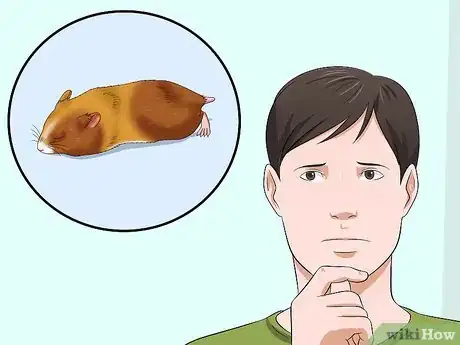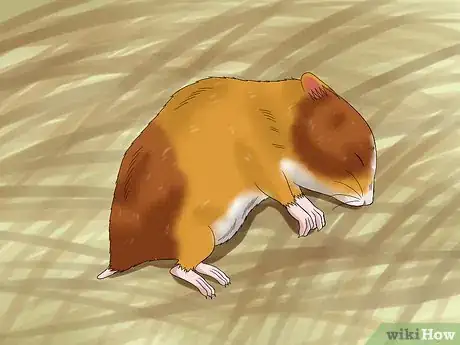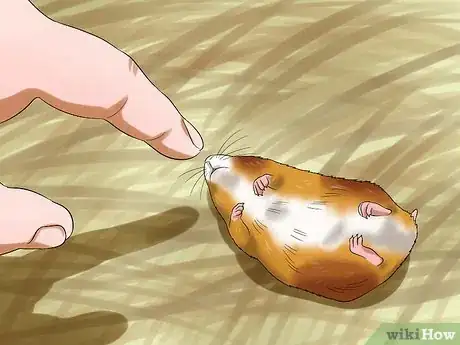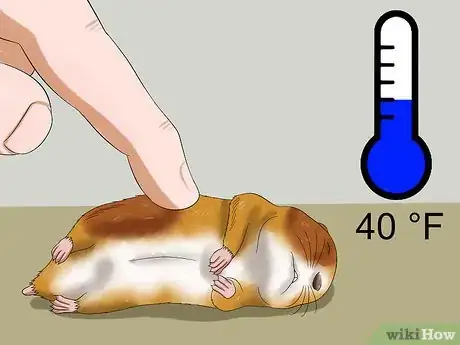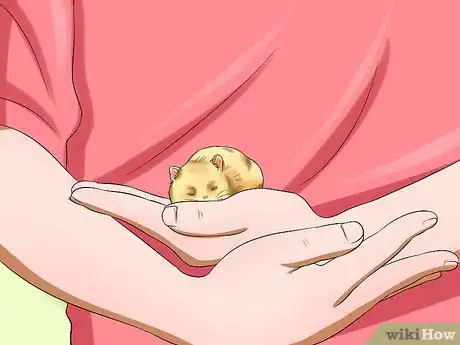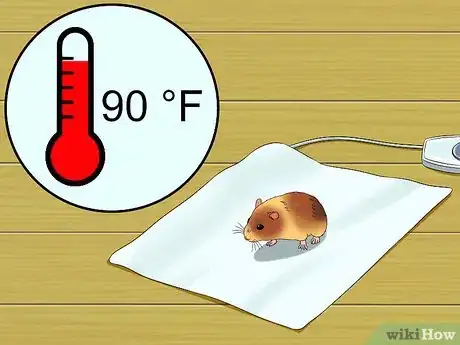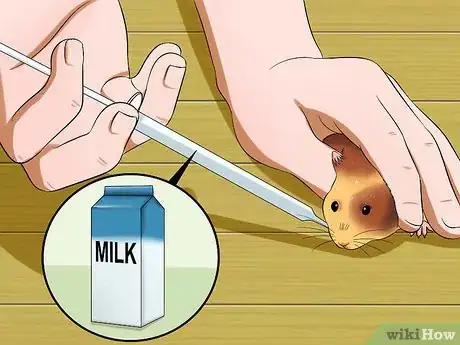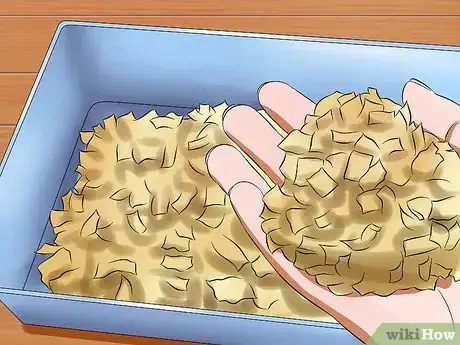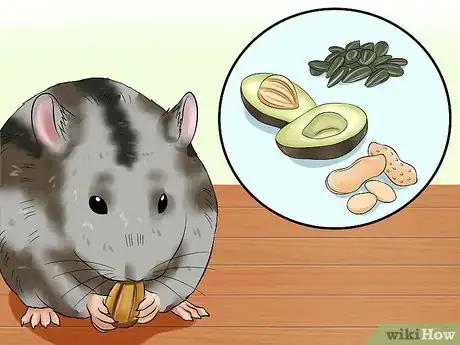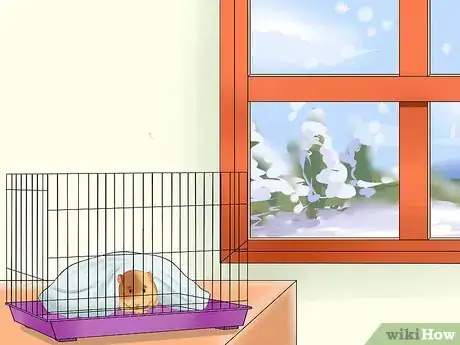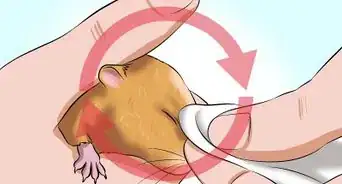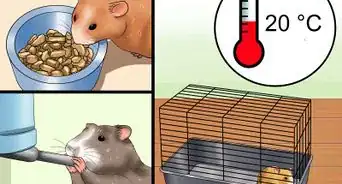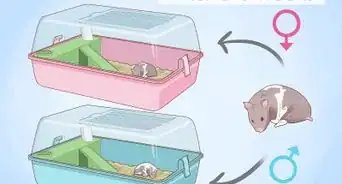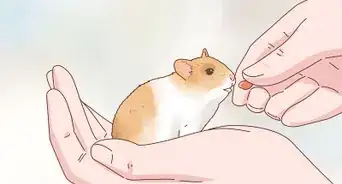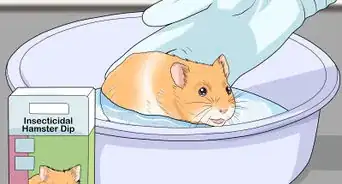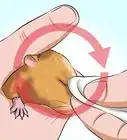This article was co-authored by Pippa Elliott, MRCVS. Dr. Elliott, BVMS, MRCVS is a veterinarian with over 30 years of experience in veterinary surgery and companion animal practice. She graduated from the University of Glasgow in 1987 with a degree in veterinary medicine and surgery. She has worked at the same animal clinic in her hometown for over 20 years.
wikiHow marks an article as reader-approved once it receives enough positive feedback. In this case, 90% of readers who voted found the article helpful, earning it our reader-approved status.
This article has been viewed 281,863 times.
Many animals have developed the ability to hibernate as a natural way to increase chances of survival during the long, cold winter season. Hamsters typically go into hibernation mode in the wild during the wintertime when the temperature drops below 40°F (4.5°C). Being mindful of their temperature sensitivities is an important part of being a hamster owner.
Steps
Determining if Your Hamster is Hibernating
-
1Know the signs. Sometimes it can be hard to tell if your hamster is simply hibernating or if it has actually died. Hamsters in a hibernating state appear still and lifeless; their breathing and heart rate slow down. They even might go weeks without eating. And with such tiny bodies, it can often be difficult to notice the subtle signs of life in a hibernating hamster.[1]
-
2Watch for movement. During true hibernation, hamsters will move very little. But sometimes they can enter a “sleep” phase of minor hibernation in which they often tremble or nod their head from side to side.[2] Noticing these kinds of movements is a good indication that your hamster is just hibernating.Advertisement
-
3Check for signs of breathing. During hibernation, your hamster’s breathing will be slower than usual, but not altogether absent. Hold your hamster in your hand and listen closely for breathing sounds. You can also put your finger near their mouth to see if you can detect any exhale breaths.
-
4Feel for body warmth. A hibernating hamster will maintain a warm body temperature though it might be slightly cooler than usual. A hamster that is truly dead will lose its body heat completely, so a warm hamster is probably a hibernating hamster.[3]
Bringing Your Hamster Out of Hibernation
-
1Try body heat. Pick your hamster up and hold it in your hand against your body. Use your body heat to provide warmth for your hamster. Keep holding it for at least 30 minutes and see if there are any changes in their behavior or if they start acting more alert.
-
2Warm your hamster with a hot water bottle. Wrap your hamster in a towel with a water bottle full of hot water. Make sure the hamster is not directly touching the water bottle and doesn’t get too hot. This will help warm his body and bring him out of hibernation.[4]
-
3Use a heating pad. Try placing your hamster on a warm heating pad that is heated to about 90°F (32°C) for 30-60 minutes. This will help your pet warm up quickly and help them come out of their state of hibernation.[5]
- If you don’t have a heating pad, try putting your hamster on a towel on top of a radiator. This will have the same effect. Just make sure you monitor your pet closely and make sure the heat isn’t too much for it to handle.
-
4Give your hamster warm milk. Once your hamster starts becoming more alert, even if only slightly alert, try to give it warm milk through a medicine dropper. You should heat the milk up in the microwave or on the stove but test it first to make sure it is not too hot. It should be tolerable to the touch. Feed it to your hamster in a bowl or in their water dropper container.[6]
- Alternatively, you can try to give your hamster plain water, water with sugar, or children’s Pedialyte with a medicine dropper.[7] Anything you can do to get them to ingest water is good. Rehydration will help your hamster come out of its hibernation state.
Preventing Future Hibernation
-
1Make sure your hamster always has enough food and water. Sometimes hibernation is triggered by a lack of food or water in order to conserve energy. To avoid sending your hamster into hibernation, ensure that it always has access to plenty of food and water.[8]
-
2Provide plenty of warm bedding. The bedding in your hamster’s cage will help insulate it and protect it from the cold. Make sure your hamster has sufficient bedding to stave off hibernation. If your hamster starts hibernating, try adding more bedding to prevent this from happening again.[9]
-
3Give your hamster a more fattening diet. Having more body fat will help prevent your hamster from going into hibernation mode. Try feeding your hamster more fattening food items like sunflower seeds, peanuts, or avocado. However, be sparing with the fatty foods because a little goes a long way with tiny hamsters.[10]
-
4Be proactive during the winter. During the cold winter months, be more mindful of your hamster’s behavior and if it seems warm enough. Maybe give your hamster some extra bedding in its cage during the winter and provide more fatty foods than normal. Keep an eye on your pet to make sure it stays safe and alert during the cold season.
Expert Q&A
Did you know you can get expert answers for this article?
Unlock expert answers by supporting wikiHow
-
QuestionHow long does it take for a hamster to come out of hibernation?
 Pippa Elliott, MRCVSDr. Elliott, BVMS, MRCVS is a veterinarian with over 30 years of experience in veterinary surgery and companion animal practice. She graduated from the University of Glasgow in 1987 with a degree in veterinary medicine and surgery. She has worked at the same animal clinic in her hometown for over 20 years.
Pippa Elliott, MRCVSDr. Elliott, BVMS, MRCVS is a veterinarian with over 30 years of experience in veterinary surgery and companion animal practice. She graduated from the University of Glasgow in 1987 with a degree in veterinary medicine and surgery. She has worked at the same animal clinic in her hometown for over 20 years.
Veterinarian
-
QuestionWhat temperature is too cold for a hamster?
 Pippa Elliott, MRCVSDr. Elliott, BVMS, MRCVS is a veterinarian with over 30 years of experience in veterinary surgery and companion animal practice. She graduated from the University of Glasgow in 1987 with a degree in veterinary medicine and surgery. She has worked at the same animal clinic in her hometown for over 20 years.
Pippa Elliott, MRCVSDr. Elliott, BVMS, MRCVS is a veterinarian with over 30 years of experience in veterinary surgery and companion animal practice. She graduated from the University of Glasgow in 1987 with a degree in veterinary medicine and surgery. She has worked at the same animal clinic in her hometown for over 20 years.
Veterinarian
-
QuestionDo pet hamsters go into hibernation?
 Pippa Elliott, MRCVSDr. Elliott, BVMS, MRCVS is a veterinarian with over 30 years of experience in veterinary surgery and companion animal practice. She graduated from the University of Glasgow in 1987 with a degree in veterinary medicine and surgery. She has worked at the same animal clinic in her hometown for over 20 years.
Pippa Elliott, MRCVSDr. Elliott, BVMS, MRCVS is a veterinarian with over 30 years of experience in veterinary surgery and companion animal practice. She graduated from the University of Glasgow in 1987 with a degree in veterinary medicine and surgery. She has worked at the same animal clinic in her hometown for over 20 years.
Veterinarian
References
- ↑ http://hamsterific.com/hamsterific-university/winterize-your-hamster/
- ↑ http://www.provet.co.uk/Hamsters/hamsters.htm
- ↑ http://www.provet.co.uk/Hamsters/hamsters.htm
- ↑ http://hamsterific.com/hamsterific-university/winterize-your-hamster/
- ↑ http://www.provet.co.uk/Petfacts/healthtips/hibernation.htm
- ↑ http://www.britishhamsterassociation.org.uk/get_article.php?fname=journal/alpha_c.htm
- ↑ http://hamsterific.com/hamsterific-university/winterize-your-hamster/
- ↑ http://hamsterific.com/hamsterific-university/winterize-your-hamster/
- ↑ http://www.britishhamsterassociation.org.uk/get_article.php?fname=journal/alpha_c.htm
About This Article
To get a hamster out of hibernation, try waking it up with body heat by holding it against your body for about 30 minutes. Alternatively, wrap your hamster in a towel and place it against a hot water bottle, or on a heating pad heated to around 90 degrees F for 30 to 60 minutes. Once your hamster starts becoming more alert, give it some warm milk through a medicine dropper to help it rehydrate and come fully out of hibernation. For more advice from our Veterinary reviewer, including how to prevent future hibernation by changing your hamster’s diet, keep reading!
